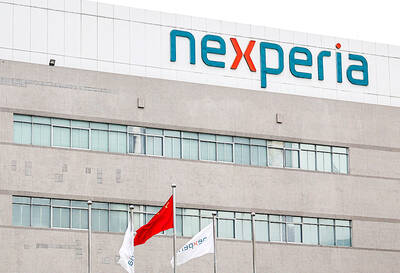Chunghwa Telecom Co (中華電信), the nation’s biggest telecom, has negotiated exclusive agency operation rights for major low-orbit satellites, the company’s chairman said today.
Through the agreements, the company could introduce Taiwanese firms into satellite supply chains and help build out the sector domestically, Chunghwa chairman Alex Chien (簡志誠) said in an interview with the Liberty Times (the Taipei Times' sister newspaper).
In addition to Chunghwa’s own ST-2 satellites, which are already in service, the company in April signed an agreement with US-based Astranis Space Technologies Corp for NT$4 billion (US$137.8 million) to build a third-generation compact geostationary orbit (MicroGEO) satellite, which would be Taiwan’s first exclusive communications satellite, he said.

Photo: Chang Chia-jui, Taipei Times
This satellite is considered a “sovereign satellite,” because Chunghwa would retain full ownership of it, including independent control and use of its full bandwidth, he said.
The goal is to retain communication security and autonomy in situations such as earthquakes or geopolitical crises, he said.
The satellite would launch at the end of this year and be in service by the second half of next year, he added.
The company is discussing satellite cooperation projects with countries in Northern Europe, Chien added.
Chunghwa has also signed a deal with Luxembourg-based SES SA, the only company in the world that operates medium Earth orbit satellites, Chien said.
The telecom has already applied for spectrum allocation from the Ministry of Digital Affairs and is awaiting approval from the National Communications Commission before launching its service, Chien said.
There are four low-orbit satellite companies in the world, but Chunghwa cannot work with one of them, Starlink, due to regulatory issues, Chien said.
Of the rest, Chunghwa has negotiated exclusive deals with Eutelsat OneWeb in the UK, the US' Kuiper Systems and Canada’s Telesat, Chien said.
Separately, to improve the resiliency of Taiwan’s international communication networks, Chunghwa aims to install seven new submarine cables and a landing station, Chien said.
The telecom at present operates seven cables and four landing stations, he added.
Two of the new cables are set to go online in the second half of this year, connecting Taiwan to Japan, Singapore and Hong Kong, and then another connecting Taiwan, Japan, Singapore and India, Chien said.
A new trans-Pacific fiber optic submarine cable, dubbed E2A, is set to go online in 2028, he added.
Taiwan also has nine domestic cables connecting its main island and outlying islands, Chien said, adding that a fourth cable between Taiwan, and Penghu, Kinmen and Lienchiang (Matsu) counties is under construction and expected to be completed next year.
The company is investing in new technologies in building these submarine cables, including artificial intelligence to ensure resiliency, he said.
The goal is to turn Taiwan into a regional hub for the communications industry, driving growth, job creation and the development of technology, Chien said.
In response to concerns about ships damaging submarine cables, the company has taken measures such as adding protective layers to them, burying them deeper underground and improving cooperation with the Coast Guard Administration, Chien said.

JITTERS: Nexperia has a 20 percent market share for chips powering simpler features such as window controls, and changing supply chains could take years European carmakers are looking into ways to scratch components made with parts from China, spooked by deepening geopolitical spats playing out through chipmaker Nexperia BV and Beijing’s export controls on rare earths. To protect operations from trade ructions, several automakers are pushing major suppliers to find permanent alternatives to Chinese semiconductors, people familiar with the matter said. The industry is considering broader changes to its supply chain to adapt to shifting geopolitics, Europe’s main suppliers lobby CLEPA head Matthias Zink said. “We had some indications already — questions like: ‘How can you supply me without this dependency on China?’” Zink, who also

The number of Taiwanese working in the US rose to a record high of 137,000 last year, driven largely by Taiwan Semiconductor Manufacturing Co’s (TSMC, 台積電) rapid overseas expansion, according to government data released yesterday. A total of 666,000 Taiwanese nationals were employed abroad last year, an increase of 45,000 from 2023 and the highest level since the COVID-19 pandemic, data from the Directorate-General of Budget, Accounting and Statistics (DGBAS) showed. Overseas employment had steadily increased between 2009 and 2019, peaking at 739,000, before plunging to 319,000 in 2021 amid US-China trade tensions, global supply chain shifts, reshoring by Taiwanese companies and

Taiwan Semiconductor Manufacturing Co (TSMC, 台積電) received about NT$147 billion (US$4.71 billion) in subsidies from the US, Japanese, German and Chinese governments over the past two years for its global expansion. Financial data compiled by the world’s largest contract chipmaker showed the company secured NT$4.77 billion in subsidies from the governments in the third quarter, bringing the total for the first three quarters of the year to about NT$71.9 billion. Along with the NT$75.16 billion in financial aid TSMC received last year, the chipmaker obtained NT$147 billion in subsidies in almost two years, the data showed. The subsidies received by its subsidiaries —

At least US$50 million for the freedom of an Emirati sheikh: That is the king’s ransom paid two weeks ago to militants linked to al-Qaeda who are pushing to topple the Malian government and impose Islamic law. Alongside a crippling fuel blockade, the Group for the Support of Islam and Muslims (JNIM) has made kidnapping wealthy foreigners for a ransom a pillar of its strategy of “economic jihad.” Its goal: Oust the junta, which has struggled to contain Mali’s decade-long insurgency since taking power following back-to-back coups in 2020 and 2021, by scaring away investors and paralyzing the west African country’s economy.